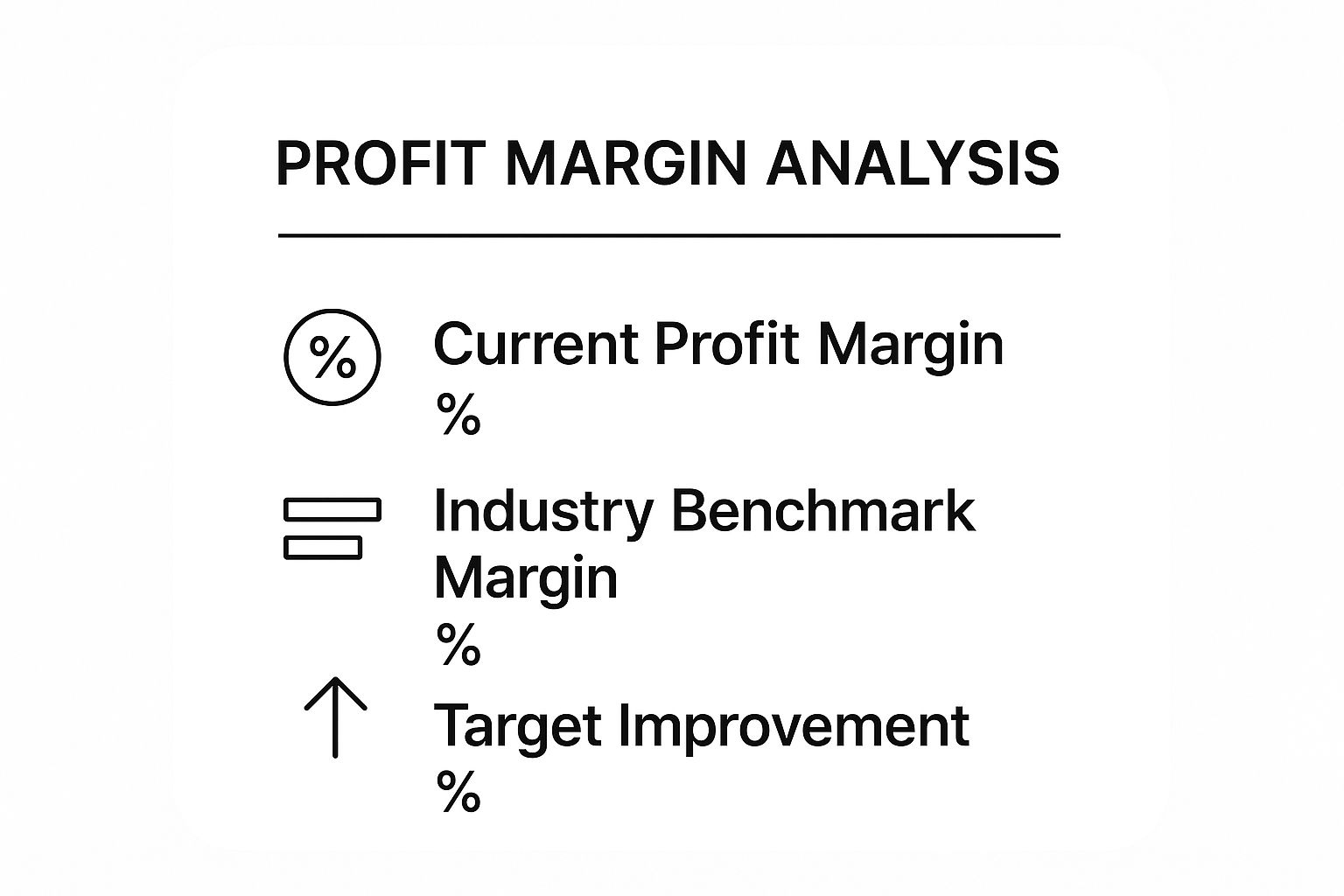Stay Updated with Everything about MDS
Thank you! Your submission has been received!
Oops! Something went wrong while submitting the form.

Chilat Doina
August 1, 2025
If you want to truly boost your e-commerce profitability, you can't just focus on selling more. That’s only one part of the equation. Real, sustainable profit comes from mastering three core areas at once: growing revenue strategically, keeping a close eye on costs, and making your operations as smooth as possible.
Building a financially healthy business means looking beyond just the top-line sales number. You need a holistic view to find the real levers you can pull to not just make money, but keep more of it. Think of it like a three-legged stool—if one leg is wobbly, the whole thing is unstable.
I’ve seen this work wonders. Take a local restaurant I know that boosted its profits by a staggering 40%. They didn't just hike up menu prices. Instead, they attacked the problem from all three angles:
This multi-pronged approach is what creates resilient, profitable companies.
Before you can improve, you have to know where you stand. A solid financial foundation is non-negotiable, which is why mastering financial management for your small business is a continuous effort, not a one-time task. It all starts with an honest look at your numbers.
The infographic below highlights the key data points you should be analyzing to get a clear picture of your current financial health.

Use this as a quick way to benchmark your performance. It helps turn abstract financial goals into a concrete starting line for your journey to better profitability.
To make this even clearer, let's break down these three core levers. Each has a specific focus and leads to distinct, positive outcomes for your bottom line.
Looking at your business through this lens helps you identify the most impactful areas for improvement right now.
While cutting costs is essential, most business leaders I talk to are laser-focused on strategic revenue growth to build long-term value. This isn’t just a gut feeling; the data backs it up.
A recent J.P. Morgan outlook report found that nearly 74% of business leaders expect their revenues to climb in the next year. And, more importantly, 65% believe that will lead directly to higher profits.
But they aren't just sitting around waiting for it to happen. To capture that growth, a proactive 53% plan to introduce new products or services, and 43% are actively seeking strategic partnerships to expand their reach. The takeaway is clear: the most successful leaders are proactive, not reactive. They see expansion as a direct path to a healthier bottom line.

When it comes to boosting your profitability, your pricing strategy is easily the most powerful tool you have. The problem is, far too many businesses get stuck in a simple cost-plus rut, where they just add a markup to their costs and call it a day. This approach leaves a ton of money on the table.
The real magic happens when you shift your thinking. Stop focusing on what a product costs you and start focusing on what it’s worth to your customer. It’s about more than just tweaking a price tag; it's a complete re-engineering of how you generate revenue to capture the maximum value you deliver. A small, smart adjustment here can have a much bigger impact than painful cost-cutting somewhere else.
Think about the classic consultant's trap: charging by the hour. It directly caps your income and, frankly, incentivizes you to be less efficient. I know a consultant who completely flipped her business model and boosted her income by 50% with one key change. She stopped selling her time and started selling results.
Instead of billing by the hour, she created fixed-price project packages built around the tangible business value she provided. Yes, it meant more work upfront to really dig into a client’s pain points and potential ROI, but the payoff was massive.
Her new offer stack looked something like this:
This tiered model let clients pick the investment level that felt right for them, while she got paid based on the outcome, not the hours she put in.
Shifting to value-based pricing decouples your revenue from your time. It forces you to clearly articulate the results you deliver, which inherently makes your service more attractive to clients who are focused on ROI.
Putting all your eggs in one revenue basket is just plain risky and puts a ceiling on your profitability. The smartest businesses build out multiple income streams that make sense with their main offering. This creates a financial safety net and unlocks new ways to grow.
Take a local gym, for example. Most of its cash comes from monthly memberships. But they can seriously pump up profits by adding related services. A corporate wellness program, for instance, opens up a whole new B2B market. They could also run special workshops, sell personal training packages, or even branded merch.
The same logic applies to e-commerce. A brick-and-mortar shop with a loyal local following can explode its reach by launching an online store. It's not just a new sales channel; it reinforces the brand and gives you priceless customer data. If you’re in this spot, make sure you explore different ecommerce pricing strategies to make sure your online and offline models are working together, not against each other.
Let's be real: not all customers are created equal. Different groups of people have different needs, different sensitivities to price, and see value in different ways. A one-size-fits-all strategy completely ignores this and leaves massive revenue opportunities untapped.
Start by slicing up your customer base into segments. You can group them by:
Once you’ve got these groups, dig into their profitability. You’ll probably find something like the 80/20 rule in action, where 20% of your customers are driving 80% of your profits. This insight is pure gold. Now you can build targeted offers, loyalty programs, or premium services just for this high-value group.
Imagine an online skincare store. They might find one segment is all about anti-aging products and isn't very price-sensitive, while another group just wants affordable daily cleansers. Instead of one price list, the store could bundle premium anti-aging items into a high-margin kit and offer a subscription discount on cleansers to lock in repeat business. This kind of tailored approach lets you capture way more value from your entire customer base.

While boosting your top-line revenue is exciting, real, sustainable profitability comes from what you keep. This means getting serious about managing your expenses. But let's be clear: this isn't about taking a hatchet to your budget and damaging your quality or team morale. It’s about being a surgeon, not a butcher.
The first thing you have to learn is how to tell the difference between two kinds of costs. First, you have 'growth costs'. These are the smart investments that actually fuel your business—think essential marketing campaigns, new product development, or critical team training. Cutting these is like yanking the engine out of your car.
Then you have the 'drain costs'. These are the silent killers of your profit margin. We're talking about redundant software subscriptions, clunky processes that waste time, and old vendor contracts that just don't make sense anymore. These are the expenses you need to hunt down and eliminate. Tackling these "drains" makes your business leaner and stronger for the long haul without killing your momentum.
One of the quickest ways to find those pesky 'drain costs' is to do a full-blown subscription and software audit. It’s incredibly easy to sign up for tools that seem like a great idea at the time, only to have them sit unused, collecting digital dust. That little $49/month tool your team stopped using? That’s nearly $600 a year straight out of your profit.
It's time to get forensic. Grab your company credit card and bank statements and go through them line by line. Make a list of every single recurring payment. Then, for each one, you need to ask some tough questions:
This one exercise, as simple as it sounds, can often uncover thousands of dollars in annual savings hiding in plain sight. It’s a fast win that gives your bottom line an immediate boost.
Juggling a bunch of different vendors for similar services isn't just an administrative nightmare—it’s a massive missed opportunity to save money. When you spread your business too thin, you have zero negotiating power. But when you consolidate your spending with one or two key vendors, you suddenly become a much more valuable client.
Think about it. Instead of using three different shipping carriers for different package sizes, run the numbers to see which one offers the best overall value for your specific shipping profile. Then, go to them and negotiate a volume discount based on giving them all of your business. This exact same logic applies to everything, from your packaging suppliers to your marketing agencies.
By becoming a bigger fish in a smaller pond, you gain the leverage to ask for better rates, more flexible payment terms, and even better service. Most vendors are more than willing to offer significant discounts to lock in a larger, more consistent stream of business.
I once worked with a small marketing agency that had a full-time administrative assistant on staff—a pretty significant fixed cost. While this person was great, a lot of their work involved repetitive tasks like scheduling meetings, sending invoices, and basic data entry. The agency owners had a lightbulb moment: they realized they weren't paying for strategic value, but for routine process execution.
So, they made a bold change. They didn't just fire someone and hope for the best; they strategically replaced the role with a mix of technology and flexible talent.
The result was staggering. They saved over $30,000 a year in salary and benefits. But here’s the key: they didn’t cut the function, they just found a smarter, more efficient way to get the same outcome. This is the very definition of cutting costs without cutting corners. They swapped a high 'drain cost' for a lower, more efficient 'growth cost'—a perfect example of how rethinking your operations can directly pad your bottom line.
To get you started, I've put together a checklist to help you spot similar opportunities in your own e-commerce business.
This table is a simple but powerful tool. Use it to audit your own expenses and identify where you can trim the fat without sacrificing muscle.
Taking the time to review these areas methodically will almost certainly reveal ways to improve your profitability. It's not about being cheap; it's about being smart and efficient with every dollar you spend.
Inefficiency is a silent profit killer. While tweaking prices and slashing obvious costs are great starting points, the real, sustainable profit comes from your day-to-day operations. This is all about making your business run so smoothly that you naturally do more with less—eliminating hidden waste, boosting your team's output, and ultimately, building a leaner, more resilient machine.
Think of it like tuning your company’s engine. A well-tuned engine doesn't just go faster; it uses less fuel to get there. The same principle applies right here. Refining your internal processes offers a direct, controllable path to a much healthier bottom line.
First things first: you need to map out your core business processes, from the moment an order is placed to the moment it lands on a customer's doorstep. Where do things get bogged down? Where do mistakes consistently happen? These friction points are exactly where your profits are leaking out.
Take a hard look at the entire lifecycle of an order:
Every single slowdown or manual touchpoint is a golden opportunity for improvement. You have to identify these weak spots before you can even think about fixing them.
Once you know where the friction is, you can bring in technology to smooth things over. The goal isn't to buy fancy software for the sake of it, but to solve the specific, tangible problems you've already identified.
For example, so many businesses burn countless hours on routine financial reporting. Instead of paying someone to manually pull data and build spreadsheets every month, you could use accounting software that spits out those reports automatically. This simple change frees up your team for more strategic work, like actually analyzing the data instead of just compiling it.
Project management tools like Asana or Trello are also fantastic for squashing communication bottlenecks. They give everyone a clear, shared view of who's doing what, which helps prevent duplicate work and missed deadlines.
I saw this firsthand with an e-commerce brand struggling with high fulfillment error rates and shipping costs that were spiraling out of control. By integrating their inventory management system directly with their logistics platform, they created a single source of truth. The result? They cut fulfillment errors by a staggering 60% and slashed their shipping costs by 20%—all within six months.
For any e-commerce business, inventory is a double-edged sword. It's your biggest asset, but it can also be your biggest liability. Too much stock ties up cash and racks up carrying costs. Too little, and you're dealing with stockouts, lost sales, and unhappy customers. The secret is finding that sweet spot with a smarter inventory system.
A just-in-time (JIT) approach, where you order products specifically to align with customer demand, can dramatically reduce the amount of cash you have tied up in unsold goods. This definitely requires solid forecasting, but the payoff in reduced storage fees and minimized risk of dead stock is enormous.
Of course, a leaner operation also helps you serve customers better, which is a key factor in increasing customer lifetime value and keeping them coming back for more.
These operational improvements are far more than just minor tweaks; they're a fundamental strategy for building a more profitable business. Investing in streamlining your operations often provides a much quicker return than chasing revenue growth alone. Globally, firms that get this right can slash operational costs by up to 20-30%.
In fact, data shows 78% of solo businesses boosted their profitability by adopting digital strategies that reduce labor costs and improve efficiency. You can see more on how small businesses are succeeding with these methods on bizplanr.ai. This creates a powerful cycle where the money you save from being more efficient directly funds your future growth and innovation.

Scaling an e-commerce brand isn’t just about making more sales; it's about building a fortress around your business. As you grow, you unlock a powerful advantage known as economies of scale. In simple terms, the bigger you get, the cheaper it becomes to sell each individual item.
This isn’t just a minor perk. It’s a core principle that creates a competitive moat, protecting your market share and directly boosting your profit margins.
Think about it like this: a small, local coffee shop has to buy its beans one bag at a time, paying full retail price. But a regional chain with 20 locations can go straight to the roaster and buy an entire pallet, negotiating a massive discount. That lower cost-per-pound goes directly to the bottom line, making it almost impossible for the little guy to compete on price without sacrificing all their profit.
This is the fundamental reason why market leaders tend to get more profitable over time. Strategic growth, even if it’s just to dominate a tiny niche, is one of the most reliable, long-term drivers of profitability you can pursue.
The magic of scale touches nearly every corner of your business. It's so much more than just getting bulk discounts on your inventory; it's about engineering a fundamentally more efficient and cost-effective operation.
Here’s where you’ll start to see the benefits pop up:
For example, our regional coffee chain can do more than just get cheap beans. It might secure an exclusive deal with a local dairy farm, locking in a price and supply that a single-location shop could never dream of. That’s how scale builds a defensive wall around your profits.
Key Takeaway: Achieving scale creates a virtuous cycle. Lower costs lead to more competitive pricing (or a bigger marketing budget), which drives more growth, which in turn unlocks even greater economies of scale.
There's a reason the biggest companies in any industry are often the most profitable. It's not just about revenue—it's the powerful combination of massive scale and a hyper-efficient business model that really separates the winners from everyone else.
The world's largest corporations are a masterclass in this principle. For example, some of the biggest global industries are mind-bogglingly large; Life & Health Insurance Carriers are projected to hit $5.53 trillion in revenue in 2025. In the U.S., Walmart pulls in an incredible $681 billion in annual revenue. But look at Amazon—with $637 billion in revenue, it's right behind Walmart but generates nearly three times the profit.
Why? Because Amazon’s entire business is built on technological scale and ruthless operational efficiency, creating a much more profitable machine. You can dig into more of this data on the world’s biggest industries at IBISWorld.com.

The lesson here isn't that you need to become Amazon. The real takeaway is to focus your growth on dominating a specific market or niche. Whether your goal is to be the #1 seller of a particular gadget on Amazon or the go-to brand for a certain product in your city, achieving that leadership position is what unlocks the efficiencies that pad your bottom line.
Alright, let's get into the nitty-gritty. Once you start trying to actually move the needle on revenue, costs, and efficiency, the real-world questions pop up fast. This is where the theory ends and action begins.
My goal here is to tackle the most common questions I hear from business owners so you can clear up any doubts and start making these changes with confidence.
This is a fantastic question because it immediately shifts your focus to the other side of the profit equation: your costs and your efficiency. Just cranking up prices isn't always the smartest move, or even an option.
First thing’s first: do a ruthless audit of every single business expense. I mean everything. You will be surprised by what you uncover. Look for those sneaky, redundant software subscriptions, inefficient shipping carriers you’ve been using for years, or supplier contracts that haven't been reviewed since you signed them. These small leaks can add up to a massive drain on your bottom line.
Next, turn that critical eye inward to your operations. Can you automate repetitive admin tasks and free up your team for work that actually makes you money? Or what about your inventory? Adopting a just-in-time approach can slash your carrying costs. Even small tweaks to your fulfillment workflow can cut down on wasted time and resources, padding your margins without ever touching the price your customer sees.
When you need results now, a two-pronged attack is your best bet. I’m talking about combining a small, strategic price increase on your top sellers with an aggressive cut to one or two major, unnecessary costs.
Think about it: making deep operational changes takes time to show results. But bumping your price by just 5% on a bestseller has an immediate impact on your gross profit margin. You will see that difference on the very next sale.
At the same time, find a big "cost leak" and plug it. Decisively. This could be anything from excessive overtime pay caused by sloppy scheduling to sky-high ad spend on a marketing channel with a terrible return. This combo—a quick revenue lift plus a significant cost cut—can produce a noticeable bump in your numbers in a single quarter.
The fastest path to profit improvement isn’t a single silver bullet. It’s the immediate impact of a small price hike combined with the swift elimination of a major cost drain. This dual approach delivers results while you work on longer-term strategies.
Just staring at your final net profit number is useless. It’s a lagging indicator that doesn’t tell you why you ended up there. To get a real grip on your business's health, you need to be watching a handful of key metrics together.
To really nail this, it's also critical to get your head around the nuances of understanding ROI and ROAS, because each tells a different part of your financial story. Tracking these metrics gives you a real-time dashboard for your company’s health, not just a final score.
For an even deeper dive into growing your online business, check out our guide on how to boost ecommerce sales with more targeted strategies.
The honest answer? It completely depends on where your business is in its lifecycle and what the market is doing. There’s no single playbook that fits everyone.
Generally, early-stage and growth-phase companies should be all-in on revenue growth. The name of the game is capturing market share, building your brand, and hitting scale. You might have to run on thinner margins for a while, but you have to build that customer base first.
On the flip side, mature businesses in stable markets often get more bang for their buck by focusing on cost-cutting and operational efficiency. When you're already established, huge revenue jumps get a lot harder. Optimizing what you already have becomes a much more powerful lever for profitability.
But here’s the key: the best strategy is never purely one or the other. It’s a dynamic balance. Even hyper-growth companies need to watch for wasteful spending, and mature businesses must always be looking for new revenue streams to avoid stagnating. It’s all about aligning your main focus with your most important strategic goals at that moment.
At Million Dollar Sellers, we know that building a truly profitable e-commerce business requires more than just good ideas—it requires elite execution and insights from people who have already scaled to the top. Our private community connects you with 7, 8, and 9-figure founders who share the strategies they're using right now to navigate the market and grow their bottom line. If you're a serious seller ready to scale smarter, discover what MDS can do for you at https://milliondollarsellers.com.
Join the Ecom Entrepreneur Community for Vetted 7-9 Figure Ecommerce Founders
Learn MoreYou may also like:
Learn more about our special events!
Check Events